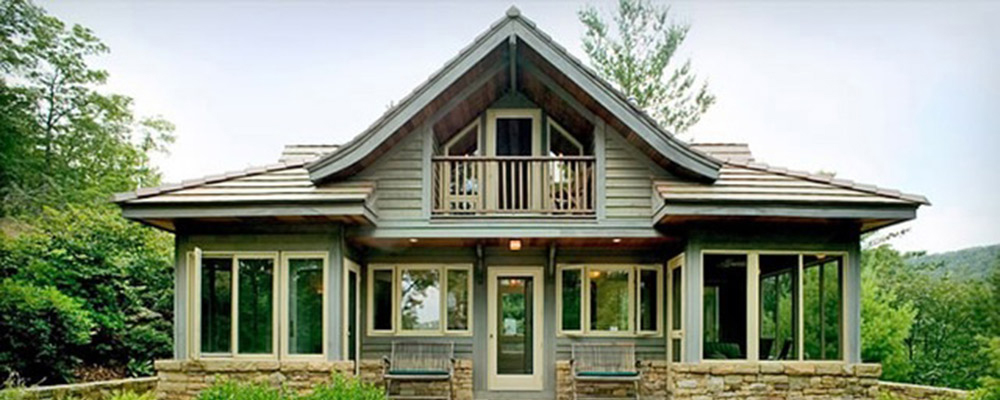Home is the womb that holds the soul
Home is the place where one is whole
—Aisha Patterson, poet
Today, more families are seeking a peaceful home to retreat to—a home that rejuvenates and revitalizes body, mind, and spirit. Such a home is a place where one is whole and life can be lived in greater harmony with nature.
This growing trend has spurred a huge expansion in alternative architecture around the world. Alternative architecture refers to a more natural and environmentally sensitive approach to home and office construction. The goal of this greener approach to building is not just beauty and functionality, but also an enrichment of human experience and a more sustainable connection to nature.
Building in Harmony with Natural Law
Many architects, builders, and homeowners who want more life-nourishing living and working environments are now turning to Maharishi Vastu® architecture. Vastu is defined as the design and construction of a building that is in harmony with the underlying principles of nature, or natural law.
Homeowners who live in such buildings report that they are experiencing improvements in their health, happiness, relationships, and even professional success. And the word is spreading. Thousands of people around the world now live and work in Maharishi Vastu homes and office buildings.
The Origins of Maharishi Vastu Architecture
Maharishi Vastu architecture is a branch of the ancient knowledge of Sthapatya Veda, preserved by the Vedic literature of India, one of the oldest continuing traditions of knowledge on earth.
To create a building in harmony with the natural world, the science of Maharishi Vastu design provides precise mathematical formulas to calculate proper orientation, proportions, dimensions, and positioning of the building—all with the goal of creating maximum harmony between the individual and nature.
Maharishi Vastu architecture is a branch of the ancient knowledge of Sthapatya Veda, preserved by the Vedic literature of India, one of the oldest continuing traditions of knowledge on earth.
Building for Good Fortune
In recent years Maharishi Mahesh Yogi, Founder of the Transcendental Meditation program, revived the knowledge of Maharishi Vastu architecture and made it available worldwide. As interest grew, architects and builders around the globe founded design firms dedicated to incorporating Maharishi Vastu principles into architectural planning and construction.
Jonathan Lipman, A.I.A., is the chief architect in the North America firm and has consulted on Maharishi Vastu construction worldwide, collectively worth close to $500 million.
“Maharishi Vastu architecture is such a comprehensive system of architectural design and planning that it even takes into account the influences of the sun, the moon, and the north and south poles in order to align individual intelligence with cosmic intelligence,” says Lipman. “The impressive results we have seen for homeowners include greater happiness, better health, and increased financial success.”
The Power of the Rising Sun
To understand these Maharishi Vastu principles, let’s look at one of the strongest influences of nature on earth—the sun. From sunrise to sunset, the sun generates varying degrees of light and energy.
According to the ancient Vedic texts, the rising sun at daybreak carries the most powerful, life-nourishing influence. Consequently, Maharishi Vastu homes face east in order to fully absorb this positive influence of the morning sunlight.
How Light Orientation Affects Health
“Very few people realize that health, happiness, and fortune may be influenced by the orientation of our homes,” says Lipman. “But the ancient Vedic texts tell us that an eastern orientation is most nourishing.” This explains recent research showing that subjects with a variety of medical conditions recuperate faster when exposed to eastern rather than western light.
A Place for Everything
Another powerful principle of Maharishi Vastu architecture is placement. “Just as the human body has a right place for each of our organs, there are ideal locations for all the major functions within a house,” says Lipman.
“This is because the sun has different qualities of energy at different times of the day,” he explains. “When we locate rooms so the activities in a house correspond to the different energies of the sun, natural law can better support each activity in the home.”
Placing the living room in the west, for example, allows the sun’s energy to support conviviality. And locating the dining room in the south is the location most conducive to digestion.
According to the ancient Vedic texts, the rising sun carries the most powerful, life-nourishing influence. Maharishi Vastu homes face east to fully absorb the positive influence of morning sunlight.
A Core of Inner Silence
According to Maharishi Vastu design principles, the exact center of a building represents the inner silence at the core of nature’s activity.
A Maharishi Vastu building’s proportions and measurements create an influence of harmony and balance. The design takes into account the effects of the building’s site and surroundings, including water bodies and the land’s slope. Furthermore, construction materials should be natural and free of toxic substances.
Just as nature operates efficiently without wasting resources, Maharishi Vastu architecture employs sustainable design to conserve energy. “The reason that the principles of Maharishi Vastu design are so powerful is that they mirror the efficiencies within the functioning of nature itself,” says Lipman.
“We’ve noticed it’s easier to be positive in our Maharishi Vastu home… There’s been an upsurge in positivity.” —Greg Spitzfaden, homeowner
Easier to Stay Positive
Greg and Linda Spitzfaden built the first Maharishi Vastu home in New England in 2000. They already practiced the Transcendental Meditation technique and had a happy family life with their three daughters, but they felt beneficial changes when they moved in.

The Maharishi Vastu home of Greg and Linda Spitzfadden in Peterborough, New Hampshire
“We’ve noticed it’s easier to be positive in our Maharishi Vastu home,” says Greg. “When someone is cranky, it tends to dissipate faster here. There’s been an upsurge in positivity.” Linda agrees. “The walls are padded in bliss,” she laughs.
Greg and Linda are thrilled that their children are settling close by. Greg jokes that one of the drawbacks of living in a Maharishi Vastu home is that you never want to leave it. “I feel so comfortable and happy here that I don’t really want to go anywhere else,” he says. “I used to travel a lot, and now I prefer to stay home.”
The Spitzfadens solved this dilemma in 2015. They built a Vastu office building in their hometown of Peterborough, New Hampshire, to house their three businesses.
The Spitzfadens’ daughter and son-in-law, DuCiel Spitzfaden and Ben Aldrich, live in an apartment in this building. Ben, age 26, first experienced Maharishi Vastu architecture while studying at Maharishi University of Management in Fairfield, Iowa.
“I notice when I’m living in a Vastu home, my habits are better,” he reports. “I feel more fulfilled and don’t have to stay up late playing one more video game or watching one more movie. So I thought, ‘Why not be in Vastu all the time?’ ”
To learn and see more about Maharishi Vastu architecture, visit maharishivastu.org ►


Comments